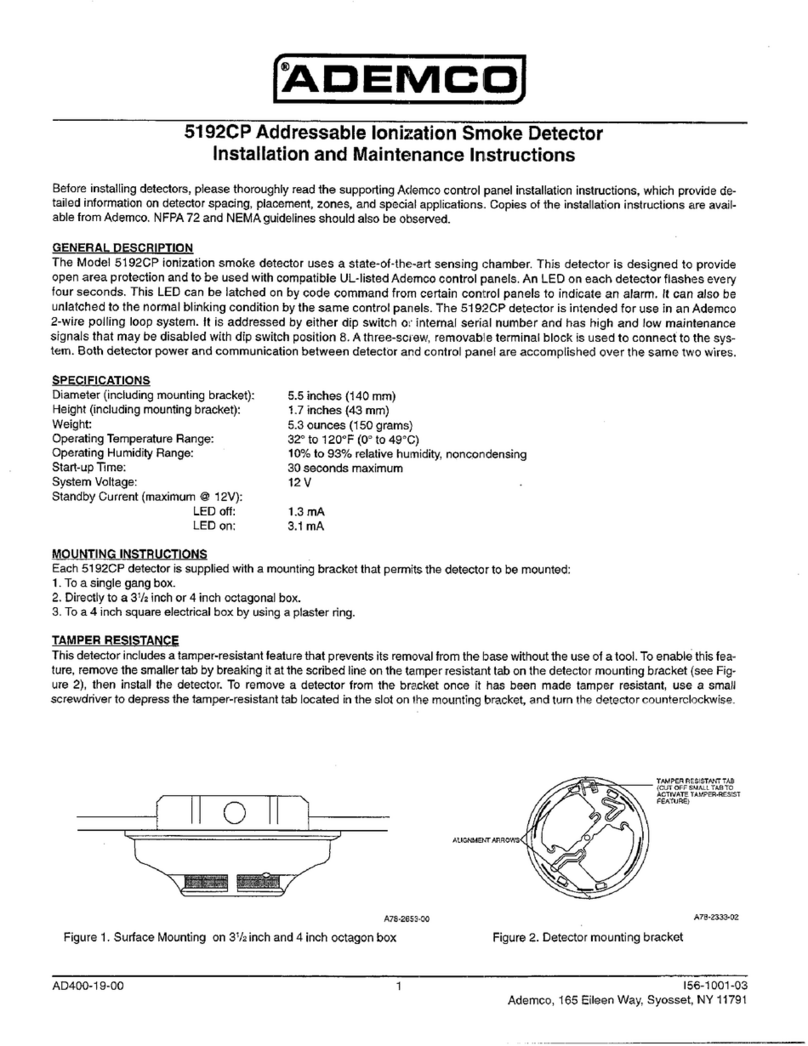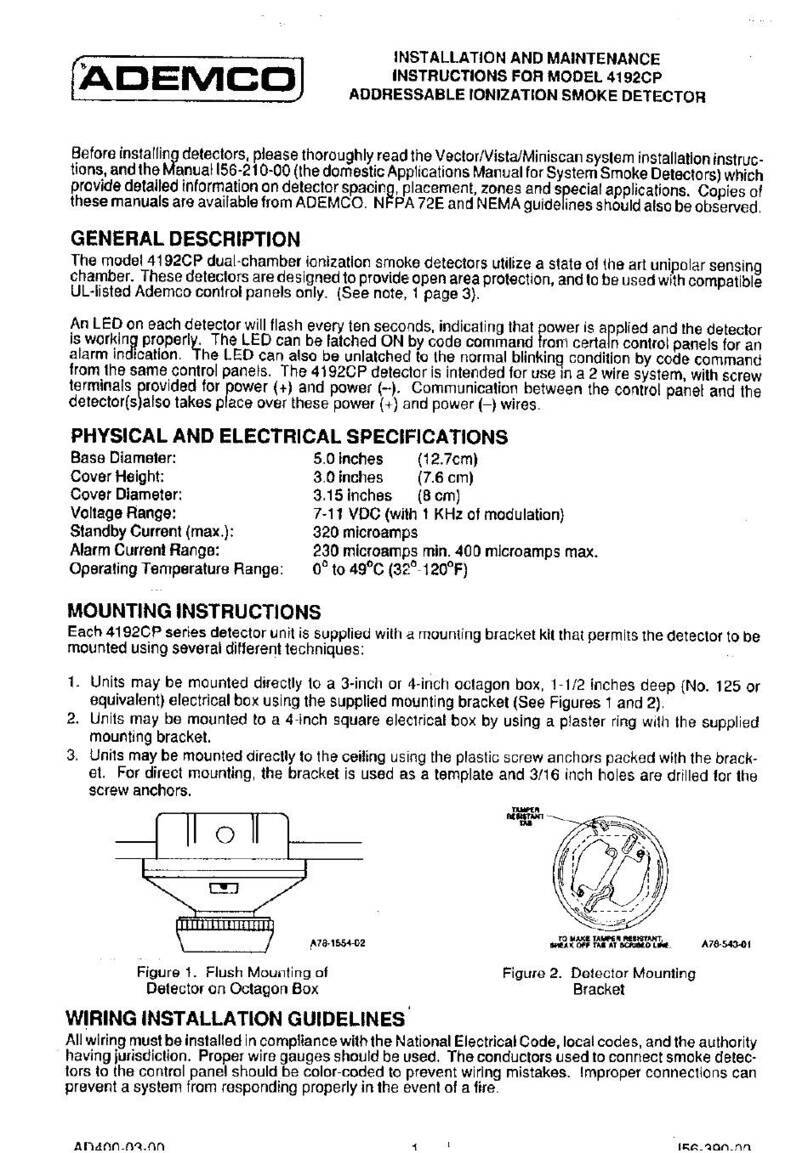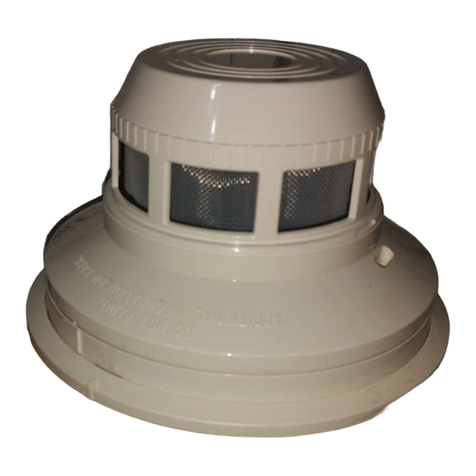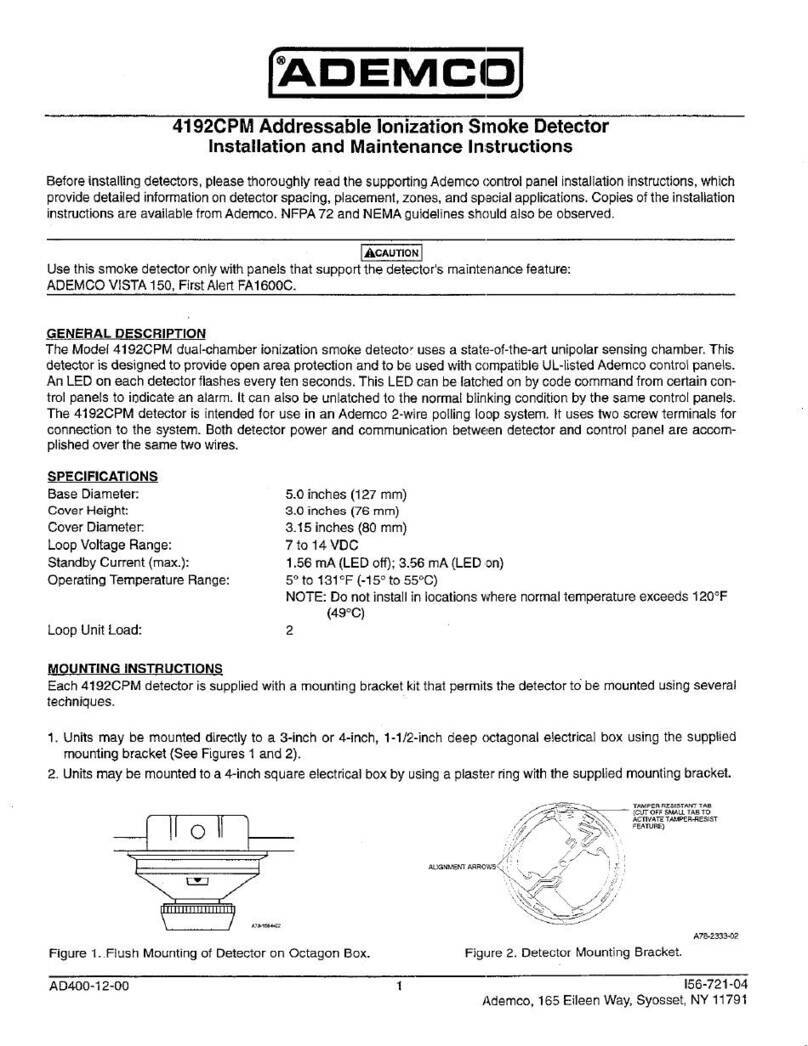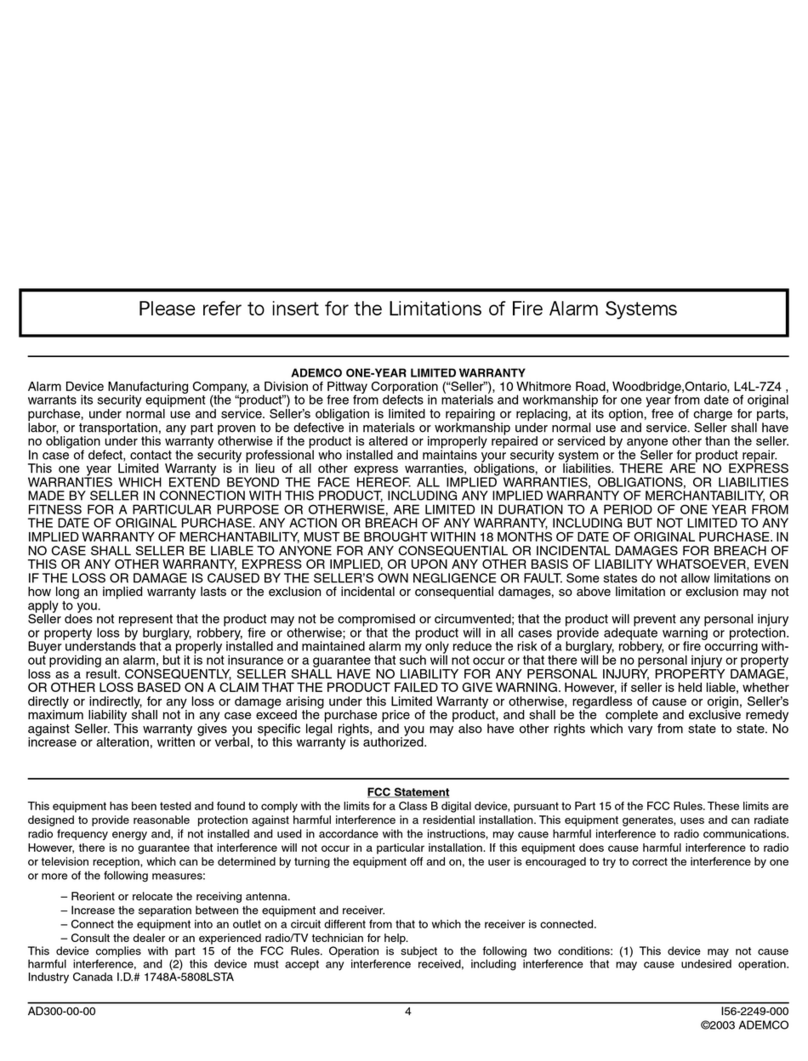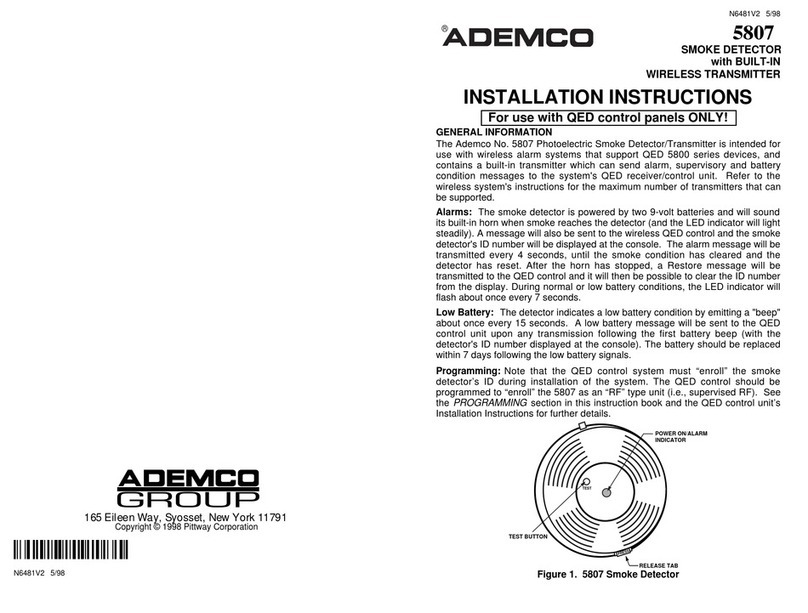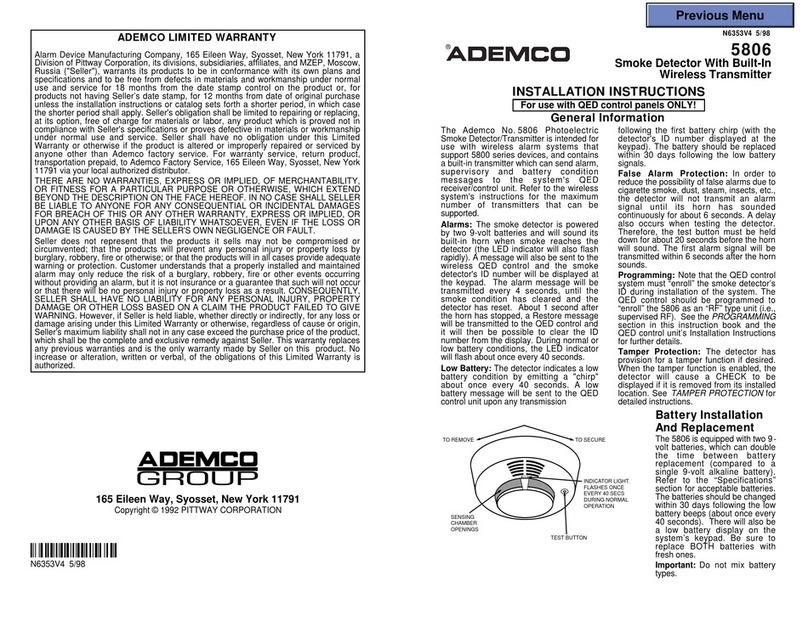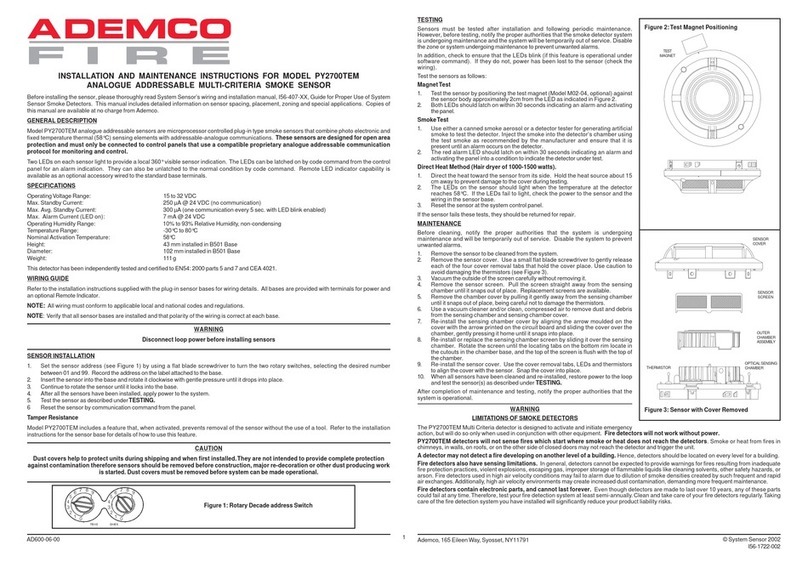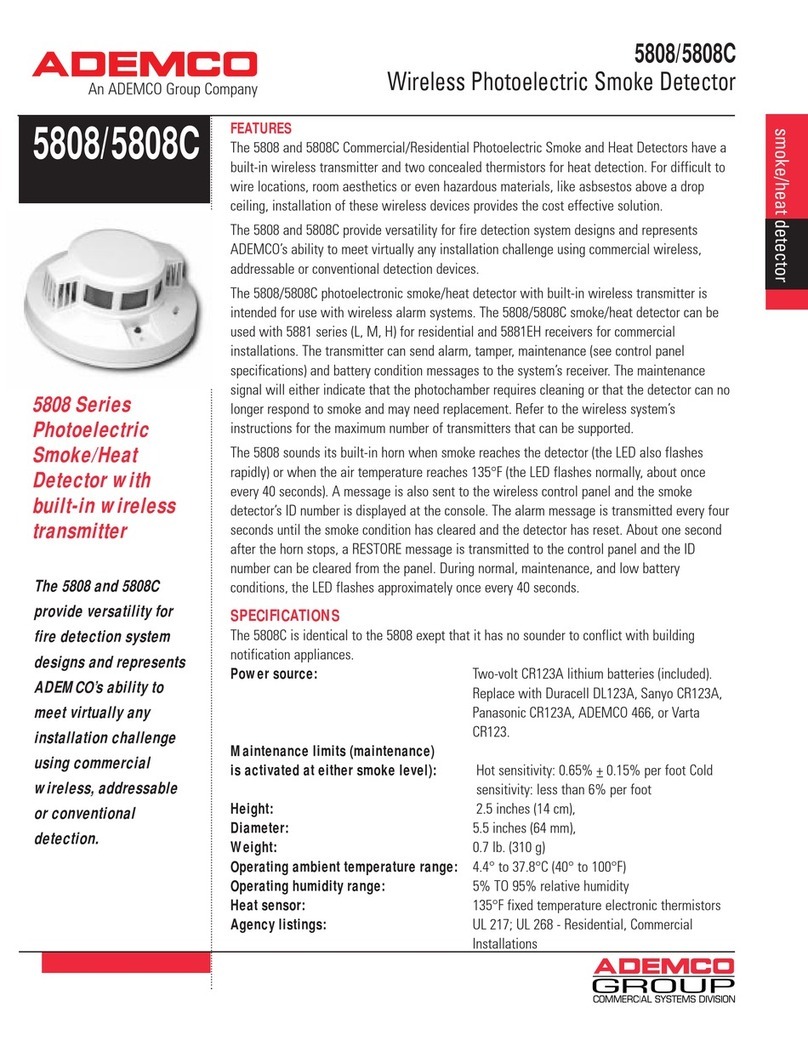
ADEMCO LIMITED WARRANTY
Alarm Device Manufacturing Company, a Division of Pittway Corporation, and its
divisions, subsidiaries and affili ates ("Seller"), 165 Eileen Way, Syosset, New York
11791, warrants its products to be in conformance with its own plans and
specifications and to be free from defects in materials and workmanship under normal
use and service for 18 months from the date stamp control on the product or, for
products not having an Ademco date stamp, for 12 months from date of original
purchase unless the installation instructions or catalog sets forth a shorter period, in
which case the shorter period shall apply. Seller's obligation shall be limited to
repairing or replacing, at its option, free of charge for materials or labor, any product
which is proved not in compliance with Seller's specifications or proves defective in
materials or workmanship under normal use and service. Seller shall have no
obligation under this Limited Warranty or otherwise if the product is altered or
improperly repaired or serviced by anyone other than Ademco factory service. For
warranty service, return product transportation prepaid, to Ademco Factory Service,
165 Eileen Way, Syosset, New York 11791.
THERE ARE NO WARRANTIES, EXPRESS OR IMPLIED, OF MERCHANTABILITY,
OR FITNESS FOR A PARTICULAR PURPOSE OR OTHERWISE, WHICH EXTEND
BEYOND THE DESCRIPTION ON THE FACE HEREOF. IN NO CASE SHALL
SELLER BE LIABLE TO ANYONE FOR ANY CONSEQUENTIAL OR INCIDENTAL
DAMAGES FOR BREACH OF THIS OR ANY OTHER WARRANTY, EXPRESS OR
IMPLIED, OR UPON ANY OTHER BASIS OF LIABILITY WHATSOEVER, EVEN IF
THE LOSS OR DAMAGE IS CAUSED BY THE SELLER'S OWN NEGLIGENCE OR
FAULT.
Seller does not represent that the products it sells may not be compromised or
circumvented; that the products will prevent any personal injury or property loss by
burglary, robbery, fire or otherwise; or that the products will in all cases provide
adequate warning or protection. Customer understands that a properly installed and
maintained alarm may only reduce the risk of a burglary, robbery, fire or other events
occurring without providing an alarm, but it is not insurance or a guarantee that such
will not occur or that there will be no personal injury or property loss as a result.
CONSEQUENTLY, SELLER SHALL HAVE NO LIABILITY FOR ANY PERSONAL
INJURY, PROPERTY DAMAGE OR OTHER LOSS BASED ON A CLAIM THE
PRODUCT FAILED TO GIVE WARNING. HOWEVER, IF SELLER IS HELD LIABLE,
WHETHER DIRECTLY OR INDIRECTLY, FOR ANY LOSS OR DAMAGE ARISING
UNDER THIS LIMITED WARRANTY OR OTHERWISE, REGARDLESS OF CAUSE
OR ORIGIN, SELLER'S MAXIMUM LIABILITY SHALL NOT IN ANY CASE EXCEED
THE PURCHASE PRICE OF THE PRODUCT, WHICH SHALL BE THE COMPLETE
AND EXCLUSIVE REMEDY AGAINST SELLER. This warranty replaces any previous
warranties and is the only warranty made by Seller on this product. No increase or
alteration, written or verbal, of the obligations of this Limited Warranty is authorized.
ALARM DEVICE MANUFACTURING CO.
A DIVISION OF PITTWAY CORPORATION
165 Eileen Way, Syosset, New York 11791
N6353V3 6/95 Copyright © 1992 Pittway Corporation
N6353V3 Ê6/95
5806
Smoke Detector With Built-In
Wireless Transmitter
INSTALLATION INSTRUCTIONS
General Information
The Ademco No. 5806 Photoelectric
Smoke Detector/Transmitter is intended for
use with wireless alarm systems that
support 5800 series devices, and contains
a built-in transmitter which can send alarm,
supervisory and battery condition
messages to the system's receiver/control
unit. Refer to the wireless system's
instructions for the maximum number of
transmitters that can be supported.
Alarms: The smoke detector is powered
by two 9-volt batteries and will sound its
built-in horn when smoke reaches the
detector (the LED indicator will also flash
rapidly). A message will also be sent to the
wireless control and the smoke detector's
ID number will be displayed at the console.
The alarm message will be transmitted
every 4 seconds, until the smoke condition
has cleared and the detector has reset.
About 1 second after the horn has stopped,
a Restore message will be transmitted to
the control and it will then be possible to
clear the ID number from the display.
During normal or low battery conditions,
the LED indicator will flash about once
every 40 seconds.
Low Battery: The detector indicates a low
battery condition by emitting a "chirp"
about once every 40 seconds. A low
battery message will be sent to the control
unit upon any transmission following the
first battery chirp (with the detector's ID
number displayed at the console). The
battery should be replaced within 30 days
following the low battery signals.
False Alarm Protection: In order to
reduce the possibility of false alarms due to
cigarette smoke, dust, steam, insects, etc.,
the detector will not transmit an alarm
signal until its horn has sounded
continuously for about 6 seconds. A delay
also occurs when testing the detector.
Therefore, the test button must be held
down for about 20 seconds before the horn
will sound. The first alarm signal will be
transmitted within 6 seconds after the horn
sounds.
Programming: Note that the control
system must ÒlearnÓ the smoke detectorÕs
ID during installation of the system. The
control should be programmed to ÒlearnÓ
the 5806 as an ÒRFÓ type unit (i.e.,
supervised RF). See the
PROGRAMMING
section in this instruction book and the
control unitÕs Installation Instructions for
further details.
Tamper Protection: The detector has
provision for a tamper function if desired.
When the tamper function is enabled, the
detector will cause a CHECK to be
displayed if it is removed from its installed
location. See
TAMPER PROTECTION
for
detailed instructions.
TO REMOVE TO SECURE
INDICATOR
LIGHT.
FLASHES ONCE
EVERY 40 SECS
DURING NORMAL
OPERATION
TEST BUTTON
SENSING
CHAMBER
OPENINGS
Battery Installation And
Replacement
The 5806 is equipped with two 9-volt
batteries, which can double the time
between battery replacement
(compared to a single 9-volt alkaline
battery). Refer to Specifications for
acceptable batteries. The batteries
should be changed within 30 days
following the low battery beeps
(about once every 40 seconds).
There will also be a low battery
display on the systemÕs console. Be
sure to replace BOTH batteries with
fresh ones.
Important: ÊDo not mix battery types.
(Continued on next page)
www.PDF-Zoo.com



